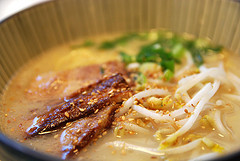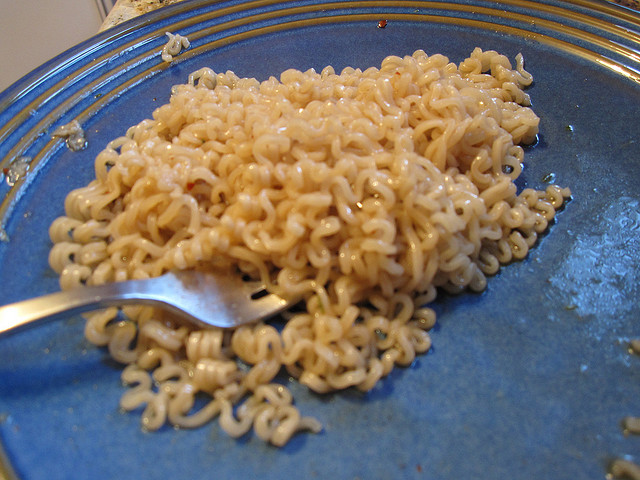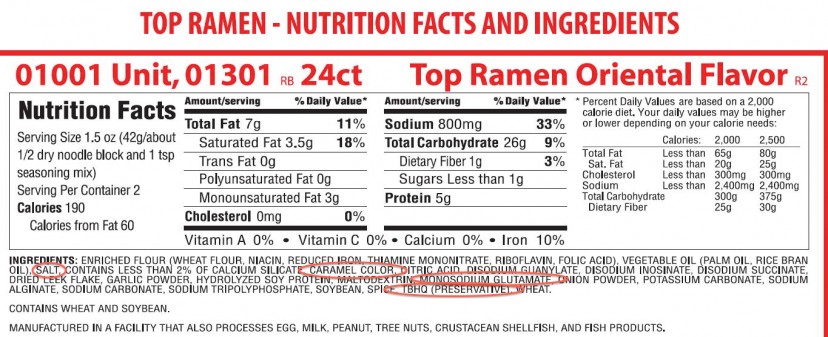Hailed for its ridiculously low price, and even easier preparation directions, instant ramen noodles are likely in every college student’s dorm room, or “starving artist” loft. Despite the misleading economic advantages of this quick and easy dish, the nutritional value is concerning. As this unhealthy choice looms on the shelves of soup aisles worldwide, it’s about time we uncover the real health concerns of eating ramen noodles.
Nutritional Facts & Ingredients
As with all food, you need to understand exactly what is going into your body! Notice how long the list of ingredients is. Let’s examine four of these ingredients.
Salt
Not only is the amount of sodium outrageous in one package of ramen noodles; the ingredient is third on the list. As you might already know, the closer to the beginning of the ingredient list, the more of it is present in the product. The serving size listed on this label is 1/2 of a noodle block and the amount of sodium present is 800mg (33% daily value based on a 2,000 calorie diet). That’s 1600mg of sodium in an entire package! This much salt in the diet has significant health risks. According to Harvard School of Public Health, excess sodium can cause high blood pressure, which in turn can lead to heart damage, disease, or even stroke. The kidneys work overtime to decrease the amount of salt in the body and this amount of excess can put extra stress on kidneys causing damage. Not only does the high amount of salt negatively affect heart health, it can also cause an increased risk for osteoporosis. The amount of calcium that your body loses via urination increases with the amount of salt that you eat. Studies suggest that reducing salt intake can help bone health to balance calcium in the body.
Caramel Color
Most artificial flavors and colors are not healthy for our bodies; caramel color is no exception. Starbucks recently gained attention from a popular blogger, Food Babe, for their pumpkin spice latte, addressing the same concerns of caramel coloring in their drinks. Many other types of drinks, such as cola, use this coloring. Links have been found between caramel coloring exposure and lung cancer. Some studies found that when levels of 4-MeI (caramel coloring) are high and coupled with long-term exposure, it can heighten risk of lung cancer.
TBHQ (Preservative)
Although many sources suggest the safety of TBHQ in food, and it is widely used for preservation, the reality of this ingredient is disturbing. TBHQ is a chemical preservative which is a form of butane. Placed within foods to extend storage life, the side effects outweigh the benefit of long shelf life. Natural News reports that high doses of TBHQ can cause nausea, delirium, collapse, and vomiting. Links have been found that suggest TBHQ long-term exposure may affect hyperactivity in children, as well as asthma. Laboratory animals tested showed a tendency to develop cancerous precursors, and even DNA damage to some. The FDA imposed “safety limits” on this additive, proving even more to the associated dangers.
MSG (Flavor Enhancer)
Monosodium glutamate, which is added as a flavor enhancer, is an excitotoxin.
MSG can make virtually anything taste good by fooling the brain. When eaten, the following complex chain reaction occurs:
- MSG is eaten.
- Cells in the arcuate nucleus of the hypothalamus that produce dopamine and regulate appetite are destroyed.
- Hypothalamus becomes leptin-resistant. Leptin is a hormone which regulates fat storage. It helps to control how much we eat.
- Glutamate (MSG) activates AMPK, an enzyme which slows metabolism AND desire for physical activity.
- The fat cells release leptin to stop AMPK, but the hypothalamus ignores the signal.
- Appetite stays high, activity is depressed. Calorie intake goes up, calories expended by metabolism go down, calories expended in activity go down.
- MSG, although it is an amino acid, signals the pancreas to release insulin.
- Insulin drops our blood sugar – causing increased hunger at the same time it packs away excess calories as fat.
- Obesity
Can You Even Pronounce These?
Not only are there high levels of these potentially harmful ingredients in ramen noodles, there’s also a laundry list of ingredients that are unpronounceable. Another good rule when choosing healthy foods and checking ingredient labels is to make sure that there are actually foods listed on them. Many times, names that we cannot pronounce just suggest processing, chemical coloring, and harmful ingredients.
One of the popular dehydrated noodle packages holds 385 calories according to the nutritional label information. Of these calories, 131 come from fat, another 223 come from carbohydrates and 31.6 come from protein. Saturated fats within one package make up 6.5 grams (almost one-third of your daily allowance).
In 2012, Dr. Braden Kuo showed what happens to your stomach after instant ramen is ingested. Watch the video for yourself! If you need even more reason, other countries’ health officials (such as Malaysia) have actually issued an official warning against eating instant noodles!
Bottom Line: Find Healthier Alternatives

No need to go for the cheap and easy way out. If you’re worried about your budget, there are plenty of ways to make homemade ramen noodle dishes without all the added preservatives, sodium, and harmful ingredients… without breaking the bank!
Traditional ramen dishes are made with noodles, broth, meat and vegetables. Recipes like this can provide healthy alternatives, which help to bridge the gap between your pocketbook and stomach. If you stick to the wholesome, real ingredients at the grocery store, you’ll be making delicious, and nutritious versions of the instant ramen like a pro in no time!









